2014 KIA Sedona fuel
[x] Cancel search: fuelPage 4 of 382
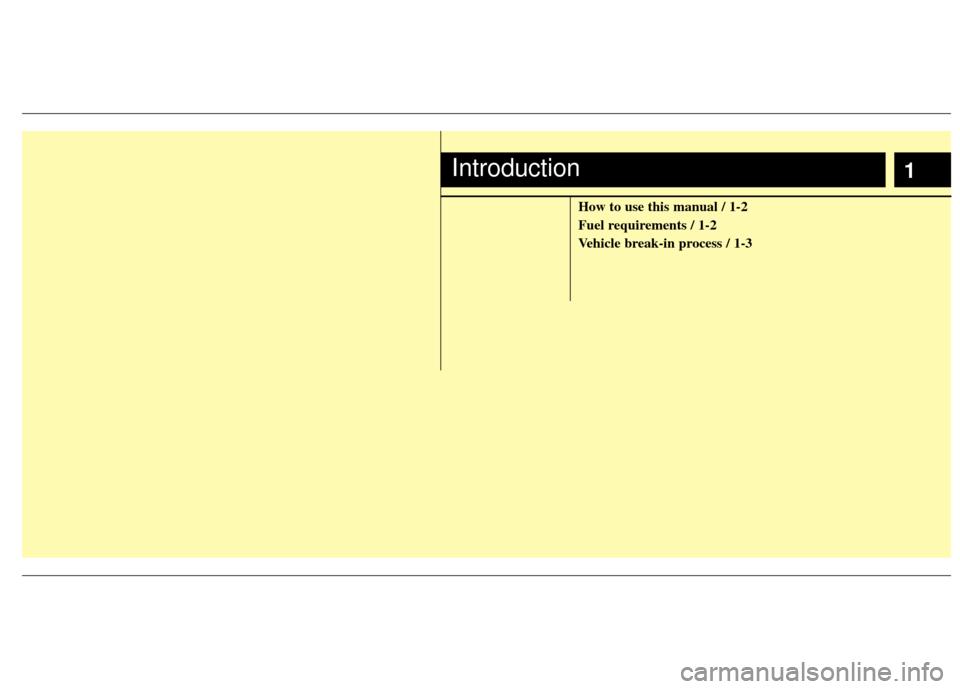
1
How to use this manual / 1-2
Fuel requirements / 1-2
Vehicle break-in process / 1-3
Introduction
Page 5 of 382
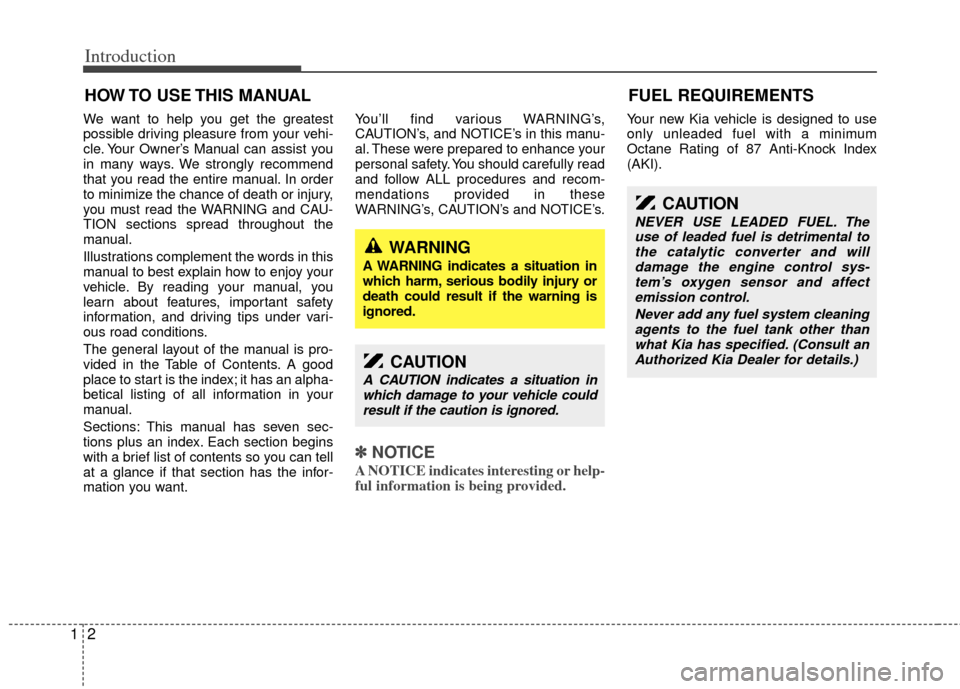
Introduction
21
We want to help you get the greatest
possible driving pleasure from your vehi-
cle. Your Owner’s Manual can assist you
in many ways. We strongly recommend
that you read the entire manual. In order
to minimize the chance of death or injury,
you must read the WARNING and CAU-
TION sections spread throughout the
manual.
Illustrations complement the words in this
manual to best explain how to enjoy your
vehicle. By reading your manual, you
learn about features, important safety
information, and driving tips under vari-
ous road conditions.
The general layout of the manual is pro-
vided in the Table of Contents. A good
place to start is the index; it has an alpha-
betical listing of all information in your
manual.
Sections: This manual has seven sec-
tions plus an index. Each section begins
with a brief list of contents so you can tell
at a glance if that section has the infor-
mation you want.You’ll find various WARNING’s,
CAUTION’s, and NOTICE’s in this manu-
al. These were prepared to enhance your
personal safety. You should carefully read
and follow ALL procedures and recom-
mendations provided in these
WARNING’s, CAUTION’s and NOTICE’s.
✽ ✽
NOTICE
A NOTICE indicates interesting or help-
ful information is being provided.
Your new Kia vehicle is designed to use
only unleaded fuel with a minimum
Octane Rating of 87 Anti-Knock Index
(AKI).
HOW TO USE THIS MANUAL
WARNING
A WARNING indicates a situation in
which harm, serious bodily injury or
death could result if the warning is
ignored.
CAUTION
A CAUTION indicates a situation in
which damage to your vehicle couldresult if the caution is ignored.
CAUTION
NEVER USE LEADED FUEL. Theuse of leaded fuel is detrimental tothe catalytic converter and willdamage the engine control sys- tem’s oxygen sensor and affectemission control.
Never add any fuel system cleaningagents to the fuel tank other than what Kia has specified. (Consult anAuthorized Kia Dealer for details.)
FUEL REQUIREMENTS
Page 6 of 382
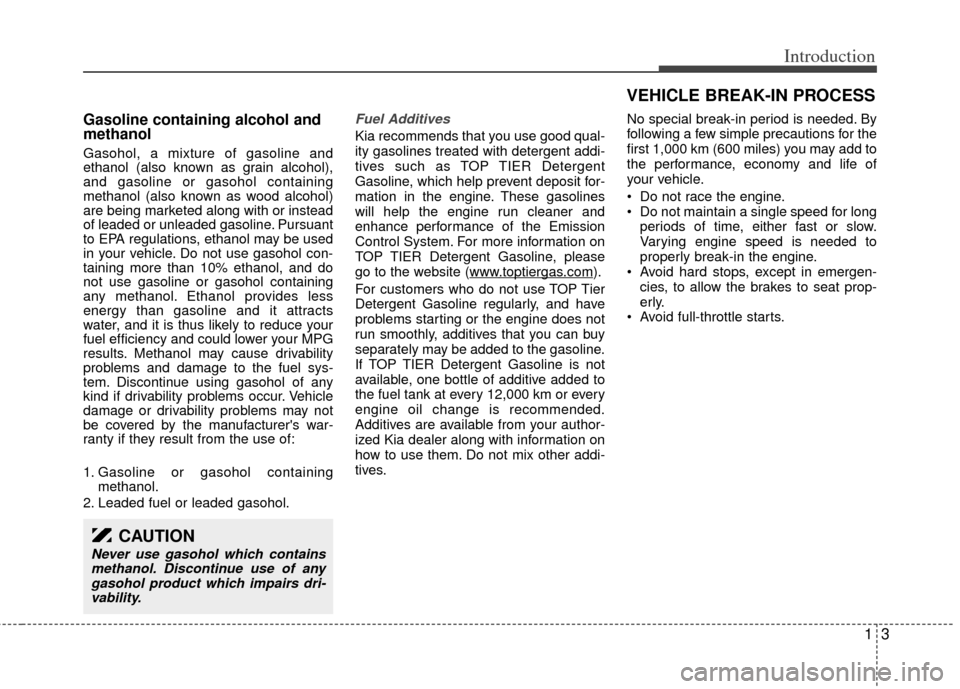
13
Introduction
Gasoline containing alcohol and
methanol
Gasohol, a mixture of gasoline and
ethanol (also known as grain alcohol),
and gasoline or gasohol containing
methanol (also known as wood alcohol)
are being marketed along with or instead
of leaded or unleaded gasoline. Pursuant
to EPA regulations, ethanol may be used
in your vehicle. Do not use gasohol con-
taining more than 10% ethanol, and do
not use gasoline or gasohol containing
any methanol. Ethanol provides less
energy than gasoline and it attracts
water, and it is thus likely to reduce your
fuel efficiency and could lower your MPG
results. Methanol may cause drivability
problems and damage to the fuel sys-
tem. Discontinue using gasohol of any
kind if drivability problems occur. Vehicle
damage or drivability problems may not
be covered by the manufacturer's war-
ranty if they result from the use of:
1. Gasoline or gasohol containingmethanol.
2. Leaded fuel or leaded gasohol.
Fuel Additives
Kia recommends that you use good qual-
ity gasolines treated with detergent addi-
tives such as TOP TIER Detergent
Gasoline, which help prevent deposit for-
mation in the engine. These gasolines
will help the engine run cleaner and
enhance performance of the Emission
Control System. For more information on
TOP TIER Detergent Gasoline, please
go to the website (www
.toptiergas.com).
For customers who do not use TOP Tier
Detergent Gasoline regularly, and have
problems starting or the engine does not
run smoothly, additives that you can buy
separately may be added to the gasoline.
If TOP TIER Detergent Gasoline is not
available, one bottle of additive added to
the fuel tank at every 12,000 km or every
engine oil change is recommended.
Additives are available from your author-
ized Kia dealer along with information on
how to use them. Do not mix other addi-
tives. No special break-in period is needed. By
following a few simple precautions for the
first 1,000 km (600 miles) you may add to
the performance, economy and life of
your vehicle.
Do not race the engine.
Do not maintain a single speed for long
periods of time, either fast or slow.
Varying engine speed is needed to
properly break-in the engine.
Avoid hard stops, except in emergen- cies, to allow the brakes to seat prop-
erly.
Avoid full-throttle starts.
CAUTION
Never use gasohol which contains methanol. Discontinue use of anygasohol product which impairs dri-vability.
VEHICLE BREAK-IN PROCESS
Page 8 of 382

Your vehicle at a glance
22
INTERIOR OVERVIEW
OVQ020001N
1. Door lock/unlock button ....................3-13
2. Driver position memory system* .......3-59
3. Seat adjust knob*..............................3-40
4. Outside rearview mirror control switch .............................................3-109
5. Power rear quarter window switches* ...........................................3-26
6. Power window switches ....................3-26
7. Central door lock switch....................3-13
8. Power window lock switch.................3-28
9. Fuel filler lid release button...............3-30
10. Instrument panel illumination* ......3-120
11. Room light main control switch .....3-133
12. Power adjustable pedal control switch*.............................................3-61
13. Steering wheel tilt .........................3-107
14. Parking brake release lever* ...........4-16
15. Fuse box .........................................6-23
16. Hood release lever .........................3-29
17. Parking brake pedal ........................4-16
18. Brake pedal .....................................4-14
19. Accelerator pedal
20. Seat.................................................3-37
* : if equipped
Page 10 of 382

3
Keys / 3-3
Remote keyless entry / 3-4
Theft-alarm system / 3-7
Immobilizer system / 3-9
Door locks / 3-11
Power sliding door and power tailgate / 3-17
Window / 3-26
Hood / 3-29
Fuel filler lid / 3-30
Sunroof / 3-33
Seat / 3-37
Driver position memory system / 3-59
Power adjustable pedals / 3-61
Safety belts / 3-62
Child restraint system / 3-76
Air bags-advanced restraint system / 3-83
Steering wheel / 3-106
Mirrors / 3-108
Instrument cluster / 3-116
Gauges / 3-117
Trip computer / 3-121
Warnings and indicators / 3-127
Features of your vehicle
Page 21 of 382
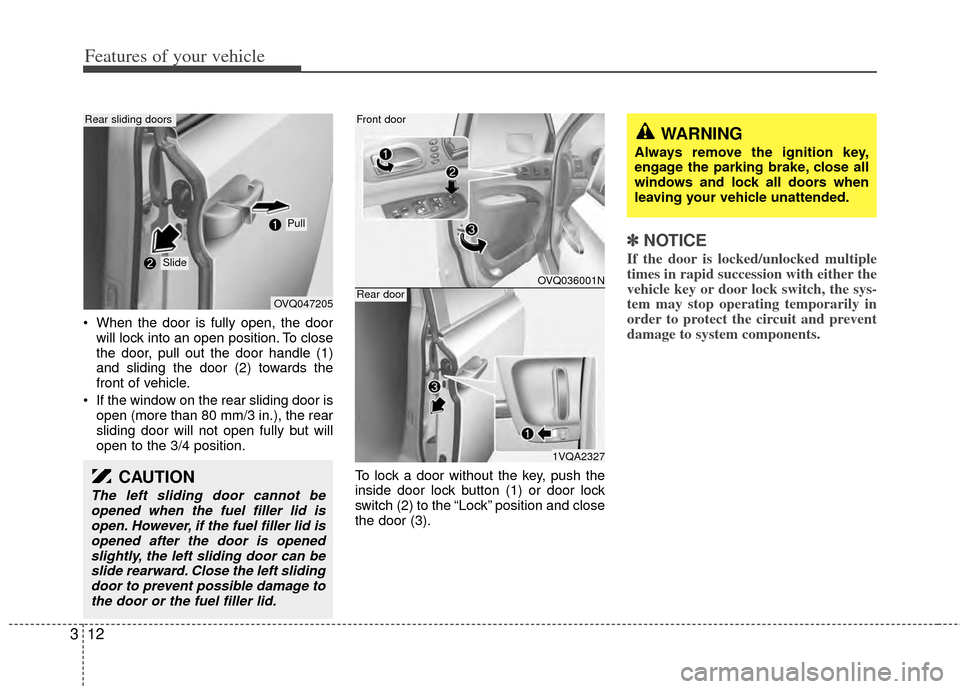
Features of your vehicle
12
3
When the door is fully open, the door
will lock into an open position. To close
the door, pull out the door handle (1)
and sliding the door (2) towards the
front of vehicle.
If the window on the rear sliding door is open (more than 80 mm/3 in.), the rear
sliding door will not open fully but will
open to the 3/4 position.
To lock a door without the key, push the
inside door lock button (1) or door lock
switch (2) to the “Lock” position and close
the door (3).
✽ ✽NOTICE
If the door is locked/unlocked multiple
times in rapid succession with either the
vehicle key or door lock switch, the sys-
tem may stop operating temporarily in
order to protect the circuit and prevent
damage to system components.
OVQ036001N
1VQA2327
Front door
Rear door
CAUTION
The left sliding door cannot be
opened when the fuel filler lid isopen. However, if the fuel filler lid is opened after the door is openedslightly, the left sliding door can beslide rearward. Close the left slidingdoor to prevent possible damage tothe door or the fuel filler lid.
WARNING
Always remove the ignition key,
engage the parking brake, close all
windows and lock all doors when
leaving your vehicle unattended.
OVQ047205
Rear sliding doors
Slide
Pull
Page 28 of 382
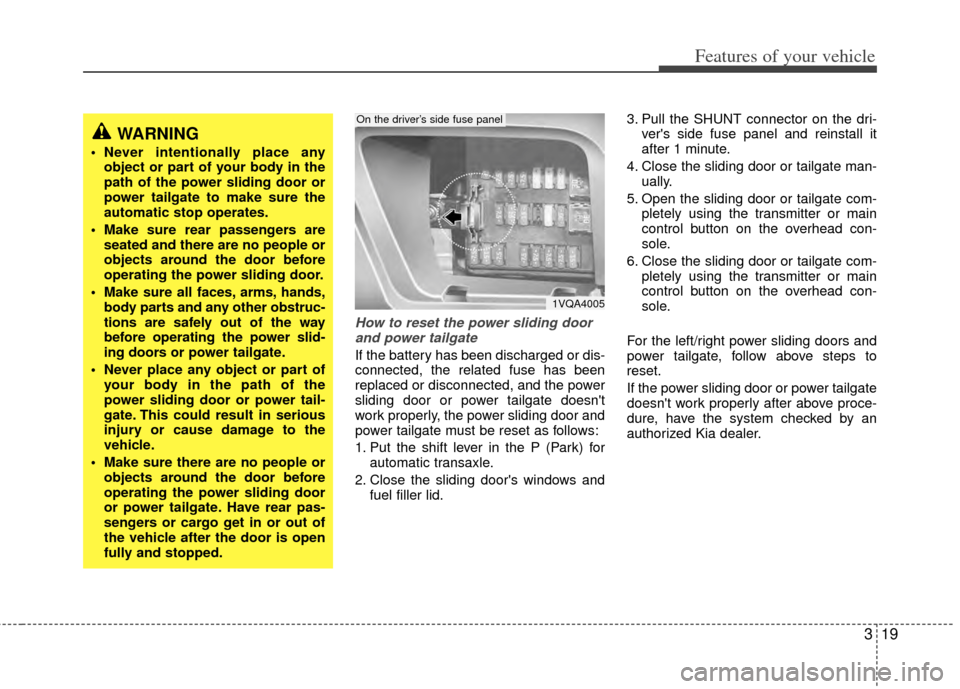
319
Features of your vehicle
How to reset the power sliding doorand power tailgate
If the battery has been discharged or dis-
connected, the related fuse has been
replaced or disconnected, and the power
sliding door or power tailgate doesn't
work properly, the power sliding door and
power tailgate must be reset as follows:
1. Put the shift lever in the P (Park) for automatic transaxle.
2. Close the sliding door's windows and fuel filler lid. 3. Pull the SHUNT connector on the dri-
ver's side fuse panel and reinstall it
after 1 minute.
4. Close the sliding door or tailgate man- ually.
5. Open the sliding door or tailgate com- pletely using the transmitter or main
control button on the overhead con-
sole.
6. Close the sliding door or tailgate com- pletely using the transmitter or main
control button on the overhead con-
sole.
For the left/right power sliding doors and
power tailgate, follow above steps to
reset.
If the power sliding door or power tailgate
doesn't work properly after above proce-
dure, have the system checked by an
authorized Kia dealer.
WARNING
Never intentionally place any object or part of your body in the
path of the power sliding door or
power tailgate to make sure the
automatic stop operates.
Make sure rear passengers are seated and there are no people or
objects around the door before
operating the power sliding door.
Make sure all faces, arms, hands, body parts and any other obstruc-
tions are safely out of the way
before operating the power slid-
ing doors or po wer tailgate.
Never place any object or part of your body in the path of the
power sliding door or power tail-
gate. This could result in serious
injury or cause damage to the
vehicle.
Make sure there are no people or objects around the door before
operating the power sliding door
or power tailgate. Have rear pas-
sengers or cargo get in or out of
the vehicle after the door is open
fully and stopped.
1VQA4005
On the driver’s side fuse panel
Page 32 of 382

323
Features of your vehicle
If the window on the power sliding dooris open (more than 80 mm/3 in.), the
power sliding door will not power open
fully but will open to the 3/4 position
and the chime will sound 3 times. To
close the door, use the transmitter or
main control button with the power
ON/OFF button in OFF position (not
depressed), or sub control button or
door handle with the power ON/OFF
button in ON position (depressed). The left power sliding door cannot be
opened while the fuel filler lid is open
fully. If the main or sub control button is
pushed, the chime sounds once. Also,
if the fuel filler lid open button is
pushed while the left power sliding
door is opening, the chime sounds
once.
✽ ✽ NOTICE
If the fuel filler lid is opened when the
left sliding door is not closed completely,
the door may be opened. Close the left
sliding door before refueling to prevent
possible damage to the door or the fuel
filler lid.
If the power sliding door is not closed
and latched completely after power
closing operation, the chime sounds 3
times. Open and close the door again.
If the power sliding door is operated while the door is in partially opened
position (less than 300 mm/12 in.), the
door is automatically opened fully.
If the power sliding door is operated while the door is in half-opened posi-
tion (more than 300 mm/12 in.), the
door is automatically closed complete-
ly. If the power sliding door is operated
again while the door is closing, the
door is automatically opened fully.
If the power sliding door is operated again while the door is opening, the
door is automatically closed complete-
ly. However, If the power sliding door is
operated again when the door is in par-
tially opened position (less than 300
mm/12 in.), the door is opened contin-
uously.
The half-opened power sliding door is automatically opened or closed fully by
pushing the door forward or backward
without pulling the door handle while
the power ON/OFF button is in ON
(depressed). However, when the door
is in partially opened position (less
than 300 mm/12 in.), the door is not
closed automatically.
WARNING
Do not leave the power sliding door
in a partially opened position. Close
the window and then open the door
fully. A partially opened door is held
and then released after 10 minutes.
The chime sounds 3 times to indi-
cate the door is released. If the
vehicle is stopped on a downward
slope, it may move and cause an
injury.